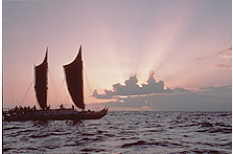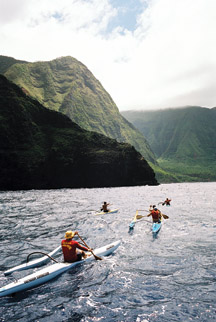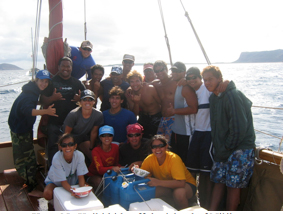PVS Newsletter / August 2006
Aloha e Na Holomoana,
On behalf of the Polynesian Voyaging Society, we are proud to present our new monthly electronic newsletter. The intent is to keep our voyaging ‘ohana abreast of Hokule‘a’s progress, as well as the current and future projects of PVS. If you have any questions, comments, concerns, or wish to update us on any other voyaging aspects, please feel free to contact us @ pvshawaii@hawaiiantel.net …we’ll be more than willing to share your news with everyone.
Mahalo Nunui, PVS Staff
Kapu Na Keiki
Kapu Na Keiki – Nihoa Trip
Kapu Na Keiki ("Hold Sacred the Children") embodies a dream envisioned more than one year ago by navigator and educator Nainoa Thompson.

Learning navigation from Nainoa. Photo by Ka'iulani Murphy
This education program is inspired by Hawai`i and the Pacific’s voyaging and canoe paddling heritage as well as the importance of exploration and discovery that embodies the spirit of the voyaging canoe Hokule`a. Through canoes, we hope to create powerful learning experiences. We hope Kapu Na Keiki will challenge the students, inspire them to explore and care for the ocean, coral reefs, these islands and their communities and encourage the values of compassion, giving and service.We also hope that this experience will help the students in navigating through their lives and the choices they face as they form and achieve their dreams. The students are required share their experiences and what they’ve learned with other students; in that way they too become educators of this land and inspire others to explore and take ownership of the caring for Hawai`i.
Mission
We seek to expose the students to Hawai‘i’s ancestral tradition of deep-sea voyaging and non-instrument navigation. The hope is that the students will develop an appreciation for Hawai`i, its people and its cultural and ecological beauty, learn the importance of caring for our environment and natural resources, enjoy the gift of physical activity, challenge themselves, be inspired to explore, exercise leadership and service, and experience the values of compassion and giving.
Goals
For everyone involved to experience, learn and grow; to involve canoeing, voyaging and educational leadership collectively under the same mission; to make contributions to underprivileged children and our environment; to translate this model to canoe clubs and to the next generation of voyagers; and to use this as a process of developing on-going programs involving the ocean and culture.
Paddling for the Children’s Justice Center
A dozen high school students in the Kapu Na Keiki program spent spring break 2006 paddling one-man and two-man canoes 95 miles up the leeward coast of the island of Hawai‘i, much of the way with the voyaging canoe Hokule‘a in sight, watching over them like a mother over her keiki.
Paddling the north coast of Moloka‘i. Photo by Monte Costa
The students collected pledges per mile they paddled and the money they raised was for the Children’s Justice Center, which serves child victims of sexual abuse and severe physical abuse. Specifically, the money will help fund art therapy projects and purchase needed items such as back-packs, which are a part of the center’s clothes closet and which are given to children who must be removed from their homes and put into foster care.
The students also made coastal paddles on Maui, Lana‘i, Kaho‘olawe, and Moloka‘i, as they moved up the island chain.
The students of Kapu Na Keiki come from varied backgrounds and from several different schools, including Wai‘anae, Nanakuli, Roosevelt, Maryknoll, Punahou, Kamehameha and the charter school Halau Ku Mana. Kapu Na Keiki is a grassroots program, funded by donations from friends and family as well as contributions from Tesoro Hawai‘i Corporation and Mauna Kea Petroleum for escort boat fuel, Island Paddler, Patagonia, The Family Shop Silk Screen Printing, Kuki‘o resort and its beach expert Thibeart, Tiger Canoes, and the Kamehameha Schools Land Assets Division.
Navigating to Ka‘ula
Under the guidance of Nainoa Thompson, 11 `opio (youths) were selected to navigate to the island of Nihoa in late July. Unfortunately, due to weather constraints, the students were forced to set their sight on Ka`ula rock (Southwest of Ni`ihau). The students navigated 80 nautical miles without instruments and found Ka`ula; a feat equivalent to 1/30 the total distance to Tahiti. According to Nainoa, “the sighting of Ka`ula was seven times more accurate than the margin of error set for the window to locate the Tuamotu Archipelago.” Congratulations to these young adults who have successfully demonstrated the potential of the next generation to perpetuate our ancient voyaging traditions.
Mahalo nui loa to the numerous hands involved in nurturing our youth, especially to their parents, mentors, and community members on the island of Kauai, whose hospitality demonstrated the essence of why Hawaii is so “special”.
Kapu Na Keiki kids off the island of Ni`ihau. Photo by Ka'iulani Murphy
The article below by Kathy Muneno appeared in Makai Ocean Lifestyle Magazine, August 2006.
The weather “was a gift,” says captain Nainoa Thompson. Wind to fill the sails and a crystal clear night. Hokupa‘a, the north star, shined bright, enabling eleven fledgling navigators to guide the Polynesian voyaging canoe Hokule‘a across the open ocean to the doorstep of a tiny island called Ka‘ula.
“I was shocked ‘cause we actually did it,” said Ka‘ulunahenahe Samson, 18 years old of Wai‘anae. She spotted the island first at 5:40am Tuesday July 25th, 2006. “Everybody was so shocked because everybody helped get us there. We felt so proud.”
“I was super happy that young kids could actually find it. So proud of everybody that we did it,” remarked Waimea McKeague, 16 years old of Nanakuli.
Thompson, who refrained from helping the students, and in fact challenged them to be sure of their estimations, saw his youth in them, “that wonderment of being able to use nature to guide you across the sea and the thrill of finding that destination you seek and in the process knowing you’re learning about something very special, being in the wake of your ancestors. Watching them search for Ka’ula was watching them grow into themselves.”

Kaula Aerial
“I think it’s gonna stay with me forever,” Waimea says.
It was the first deep-sea sail for these eleven teenagers, 16 to 19 years old, from public, private and charter schools. They are a part of the Polynesian Voyaging Society’s program called Kapu Na Keiki. The program started two years ago with Thompson teaching them how to read nature’s clues and leading them on a statewide paddle in one and two-man canoes while raising money for abused children. They made it from Ka Lae (South Point), Hawai‘i Island, to O‘ahu over a series of weeks and weekends. All that was left was Kaua‘i and Ni‘ihau. But, with a voyage to Micronesia and Japan on the horizon and sea trials and crew training to be done, Thompson decided to conduct two months of intensive navigation classes and have them instead sail to Kaua‘i and Ni‘ihau, then on to Nihoa.
But Daniel got in the way. Hurricane Daniel, that is.
“Given the forecast for Daniel, the strength of the storm, time of arrival, there was no choice. It was too dangerous to consider Nihoa as planned, it was too far west and we’d be coming back into the storm,” Thompson said. So he looked at alternatives for a navigational challenge within reasonable safety parameters, and devised the plan to leave Hanalei before sunset on Monday July 24th and voyage to Ka‘ula, west of Ni‘ihau, instead. They had to first sail to a predetermined location out of sight of land, then turn toward Ka‘ula. If the students calculated speed, time, distance and location accurately purely by looking at the ocean and the heavens, they would see Ka‘ula by sunrise the next day. They worked in three watches and called in their estimated location to the escort boat captain Mike Taylor every hour on the hour.
Before contacting Taylor by radio “we would tell Nainoa where we think we are and he would say ‘are you sure? Is that what you think?’ Then we’d go back and double-check,” recalls Samson.
Taylor was amazed and proud. When he compared their estimates to their actual GPS-plotted location he says they were “quite close,” but never told them so, of course.
They sailed 75 miles,1/30th the distance to Tahiti. Thompson points out that when Hokule‘a voyages to Tahiti “the target we shoot for is the set of islands that screen Tahiti, 440 miles wide. Say the students were 4 miles off (that is not confirmed yet and Thompson feels it is likely an over-estimate), that would equal 120 miles (if they were sailing to Tahiti), which is way within the boundaries of finding the Tuamotu Archipelago. Are they prepared to find Tahiti? No way, but it’s a cool thought.”
Ask Thompson “why teach them navigation?” and he unleashes a torrent of reasons. Non-instrument navigation, Thompson says, “gives them a sense of connection to Hawai‘i, it connects them to nature and bridges modern science and traditional knowledge. It challenges them, forces them to work as a team with family values, forces them to deal with the issue of fear, helps them to grow by using fear to keep them alert….it teaches them vision, values and community, everything that helps them grow and broaden their connection to the ocean and reconnect them to our heritage, culture and history and helps them learn how to succeed by taking on difficult challenges, through training, learning and preparation. It helps them to be more proud of themselves. It raises self-esteem through success. It helps them to look at who they are, where they’re going and helps them think of how they’re gonna get there. Also, we had them think about why Hawai‘i is so special - naturally, culturally and as a community. The voyaging process teaches values, about taking care of oneself, each other and the things that make Hawai‘i so special.”
“I’ve matured. I’m no longer the kolohe kid. I’m much calmer now,” confides McKeague.
Samson contemplates what she carries with her and sums it up with “the knowledge that we learned from Nainoa and trusting everyone else too.” She adds that “we were stoked that we were able to do that ‘cause we know, how many people are gonna get the chance to go on Hokule‘a and do that? Not too much. We were so happy to get the opportunity.”
While on Kaua‘i the students were overwhelmingly embraced by the community and they gave back. They pulled weeds in the lo‘i at Waipa, conducted a beach clean-up at Hanalei and helped lash the canoe Na Mahoe. In addition to Thompson, their mentors were their watch captains, Bruce Blankenfeld, Ka‘iulani Murphy and Atwood Makanani who made sure they took care of Hokule‘a, because Hokule‘a takes care of them.
The students wrote in journals, a requirement by Thompson. They had to answer his calculated questions such as “Where do you want to be in 20 years?” “How will you get there?” “What makes Hawai‘i unique?” “How do we keep it that way?” and the daunting “Who are you?”
McKeague acknowledges “that’s a good question. I was thinking wow, who am I now. I’m myself, I’m a Hawaiian guy, but I don’t know. Maybe just another local boy from Nanakuli…who learned from the best.” And one who helped pull an island out of the sea.
Hokule`a Benefit Concert – July 8th, 2006 @ Waikiki Shell
A night under the stars to celebrate 30 years of Hokule`a’s voyaging history was nothing short of a memorable event. The night included a tribute to Herb Kawainui Kane, Dr. Ben Finney, and Tommy Holmes (the founders of PVS), the first generation of voyagers (represented by the 1976 crew), as well as Eddie Aikau, and the honorable Master Navigator, Pius “Mau” Piailug. Mahalo nunui to Tim Guard for hosting the event, First Hawaiian Bank for its title sponsorship, all those who purchased tickets and tables, and to the numerous volunteers who came together to make the event a success

’76 Crew Members onstage at concert. Photo by Ka’iulani Murphy
Voyage Update – Dry-dock
Ku Holo Mau, a voyage to Micronesia to honor the master navigator Pius “Mau” Piailug, in culmination with Ku Holo La Komohana, a voyage continuing on to Japan, will take place from January through May of 2007. In preparation of the upcoming voyages, we will be hauling Hokule`a out of the water on Tuesday, September 5th @ METC. Hokule`a will be in dry-dock for two months (through the first week of November). If you wish to assist with Hokule`a’s restoration and preparation for the voyage, we shall be hosting dry-dock sessions Monday-Saturday (times TBA). On Hokule`a’s haul-out date, we will also be launching Hoku Alaka`i (the wa`a kaulua built for Hilo’s `Aha Punana Leo program). If you wish to kokua, please contact the PVS office: (808) 536-8405 for more details.
E lauhoe mai na wa'a; i ke ka, i ka hoe; i ka hoe, i ke ka; pae aku i ka ‘aina “Everybody paddle the canoes together; bail and paddle, paddle and bail, and the shore will be reached." If everybody pitches in, the work is quickly done.

Hokule‘a at METC. Malama Wa‘a 2006
Updated Website & Hotline
PVS is proud to announce a new comprehensive website, with current and archival information on Hokule`a and her numerous voyages, including the upcoming voyages in 2007 Ku Holo Mau (“Sail On, Sail Always, Sail Forever”) to Micronesia, and Ku Holo La Komohana (“Sail On to the Western Sun”) to Japan. We are also proud to announce a new hotline service. This automated phone system will give daily/weekly updates on Hokule`a, to provide information on her status and location. Mahalo nui loa to Dennis Kawaharada for resuming his position as webmaster, and to Ramona Ontiveros for activating and maintaining our new hotline.

“Ku Holo Mau, e Hokule`a…”
If you wish to gather current information on any aspect of Hokule‘a, her voyages, and/or educational prospects, visit the new website @ http://www.pvs.hawaii.org.
Hokule‘a – “The Legacy” (A Musical Tribute CD)
The concert was a musical tribute to Hokule‘a and her 30 years of voyaging. Now, you can share those memories in an authentic compilation CD featuring songs and chants of Hokule‘a – Hawaii’s beloved treasure. The album was produced by Ken Makuakane, and features an array of local artists, including some of the Kamehameha Schools students and alumni, and Eddie Aikau singing a song he wrote about Hokule‘a.

This CD is, “an expression of the commitment, courage, and achievement that Hokule`a represents.” Available from PVS for a donation of $20.00. See contact information in the footer of this webpage.
*Note: All proceeds from this CD support the Polynesian Voyaging Society’s ongoing efforts to Navigating Change to motivate all of us to care for our island home and ocean resources through the inspiration of exploration and discovery.


